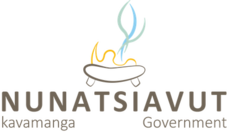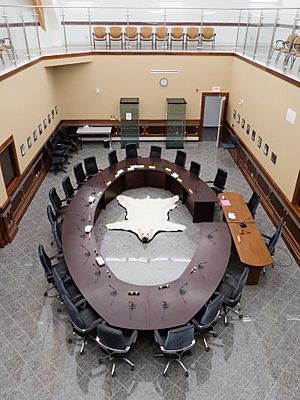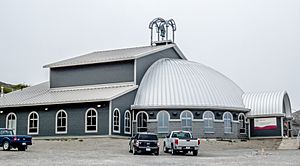Nunatsiavut Assembly facts for kids
Quick facts for kids Nunatsiavut AssemblyNunatsiavut katimajitsuangit |
|
|---|---|
 |
|
| Type | |
| Type | |
| Leadership | |
|
President
|
|
|
First Minister
|
Tony Andersen, non-partisan consensus government
|
|
Speaker of the Nunatsiavut Assembly
|
Edward Blake-Rudowski, non-partisan consensus government
Since 2017 |
| Seats | 18 |
| Meeting place | |
 |
|
| Nunatsiavut Assembly Building, Hopedale, Newfoundland and Labrador | |
| Website | |
| Nunatsiavut Assembly | |
The Nunatsiavut Assembly is like the main law-making group for the government of Nunatsiavut, Canada. It's where important decisions are made for the Inuit people living in this special region. Think of it as their parliament or legislature.
Contents
How Nunatsiavut Was Formed
On January 22, 2005, the Inuit people of Nunatsiavut signed an important agreement. This was called the Labrador Inuit Lands Claims Agreement. They signed it with the Canadian government and the government of Newfoundland and Labrador.
What the Agreement Means
This agreement gave the Inuit special rights over a large area of land. This land is about 72,520 km2 (28,000 sq mi) in size. It covers the northern part of Labrador, including the area north of Nain. The agreement also gave them rights over 44,030 km2 (17,000 sq mi) of ocean.
Even though they don't own all this land, the Inuit gained special rights. These rights are for how they traditionally use the land. They also gained ownership of 15,800 km2 (6,100 sq mi) of land. This land is called Labrador Inuit Lands.
A Protected Treaty
The Labrador Inuit Lands Claims Agreement is a treaty. It is protected by the Canadian Constitution. This means it is a very strong and important agreement. It helps protect the rights of Indigenous peoples in Canada.
The Inuit of Labrador, the government of Newfoundland and Labrador, and the Canadian Parliament all approved this agreement. It officially became law on June 23, 2005.
Starting the Government
On December 1, 2005, the Nunatsiavut government officially began. An interim government was set up. This government was made up of members from the Labrador Inuit Association. This day was a big step. It meant the Nunatsiavut government could start making its own laws. These laws cover things like culture, education, and health for their people.
In October 2006, Nunatsiavut held its first election. Nine members were chosen to form the new government. They were sworn in on October 16 in Hopedale. The current Nunatsiavut Assembly Building in Hopedale opened in 2012. In February 2021, Marlene Winters-Wheeler became the Speaker.
How Members Are Chosen
The Nunatsiavut Assembly has 10 regular members. Six of these members represent areas within Nunatsiavut. Four members represent Inuit living outside Nunatsiavut, in other parts of Canada.
Who Else Is in the Assembly?
Besides the 10 regular members, the President of Nunatsiavut is also part of the Assembly. The leaders of the Inuit Community governments also join. These leaders are called "AngajukKâk." They are like mayors for their communities.
The chairpersons of two special Inuit corporations also serve. These corporations are the NunaKatiget Community Corporation and the Sivunivut Inuit Community Corporation. They represent Inuit living in the Upper Lake Melville area.
Voting in Elections
Only Inuit residents can vote in Nunatsiavut's elections. Inuit people make up most of the population in Nunatsiavut. Other groups are represented in local town councils. These councils have a non-Inuit member to speak for them. Nunatsiavut does not use a political party system.
Who Are the Current Members?
| Riding | Member |
|---|---|
| From Nunatsiavut Communities | |
| Hopedale | Greg Flowers |
| Makkovik | John Andersen |
| Nain | Tony Andersen Jim Lyall |
| Postville | Tyler Edmunds |
| Rigolet | Carlene Palliser |
| From Other Areas in Canada | |
| Canada | Susan Sonya Onalik Roland Saunders |
| Upper Lake Melville | Gerald Asivak Marlene Winters-Wheeler |
Additional Leaders in the Assembly
The President of Nunatsiavut is a key member of the Assembly. Since 2016, Johannes Lampe has held this important role.
Community Leaders (AngajukKâk)
The leaders of the Inuit Community governments also serve in the Assembly. They represent their local communities.
| Inuit Community Government | Member |
|---|---|
| AngajukKâk for Hopedale | Majorie Flowers |
| AngajukKâk for Makkovik | Barry Andersen |
| AngajukKâk for Nain | Julius Dicker |
| AngajukKâk for Postville | Glen Sheppard |
| AngajukKâk for Rigolet | Charlotte Wolfrey |
Corporation Chairpersons
The chairpersons of two community corporations are also part of the Assembly.
| Corporation | Chairperson |
|---|---|
| NunaKatiget Community Corporation | Patricia Kemuksigak |
| Sivunivut Inuit Community Corporation | Maxene Winters |
The Executive Council
The Executive Council is like the cabinet of the Nunatsiavut government. These members are called Ministers. Each Minister is in charge of a specific area.
| Area of Responsibility | Minister | District Represented |
|---|---|---|
| First Minister | Tony Andersen | Nain |
| Finance, Human Resources, & Information Technology | Tyler Edmunds | Postville |
| Education & Economic Development | Carlene Palliser | Rigolet |
| Health & Social Development | Gerald Asivak | Upper Lake Melville |
| Lands & Natural Resources | Greg Flowers | Hopedale |
| Language, Culture, & Tourism | Jim Lyall | Nain |
Past First Ministers
The First Minister is a very important leader in Nunatsiavut. Here are some people who have held this role:


